In South Africa, tilapia fish farming is becoming an increasingly popular venture with promising business prospects. In this blog, we’ll delve into the essentials of starting a tilapia fish farming operation, complete with a detailed business plan, cost breakdown, and profit analysis. Whether you’re an entrepreneur or just starting in the aquaculture industry, this comprehensive guide will provide valuable insights into tilapia farming. Get ready to explore this exciting venture’s scientific and financial aspects, all presented clearly and straightforwardly.
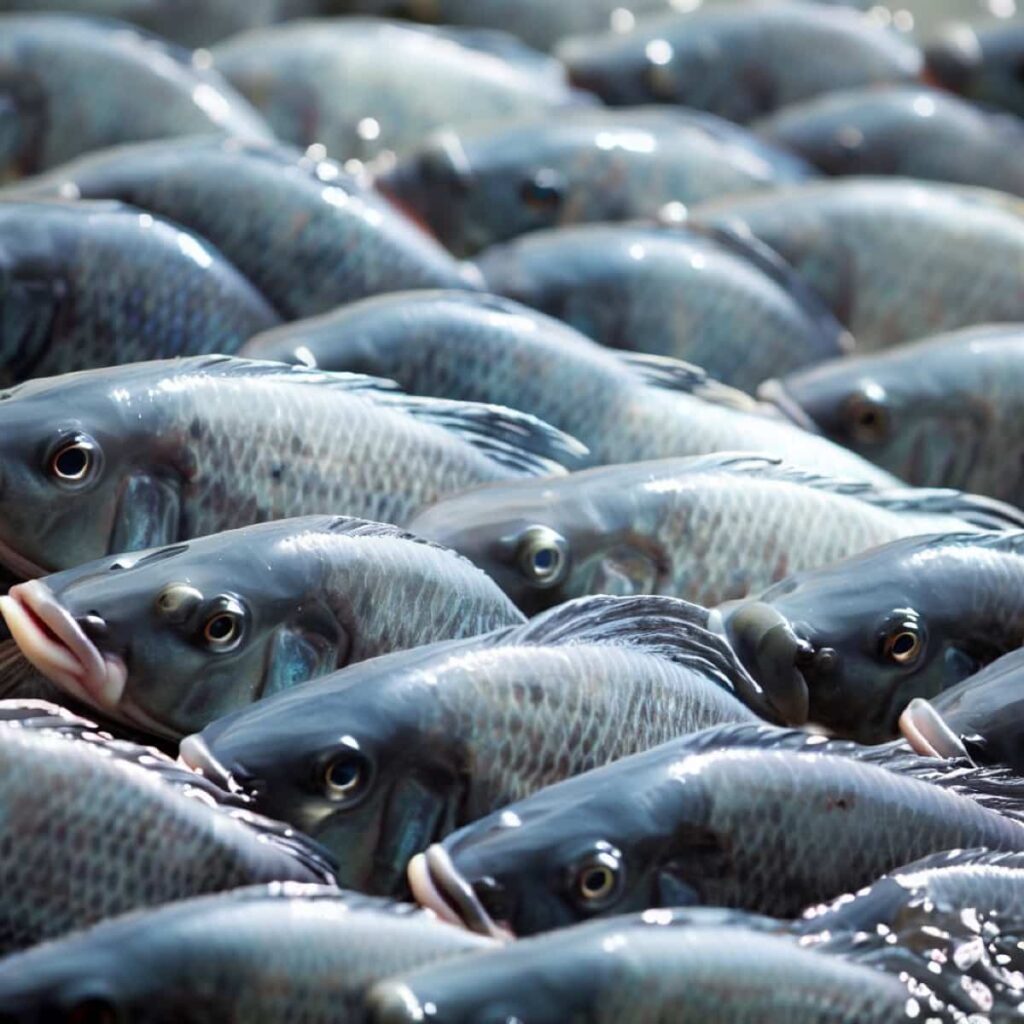
Introduction to Tilapia Fish Farming in South Africa
With over 30,000 fish species worldwide, one that stands out is the beloved tilapia. This delectable fish enjoys global popularity, with its consumption steadily climbing yearly. Enter the world of tilapia fish farming in South Africa, a highly profitable venture embraced by entrepreneurs worldwide. You must have a strong tilapia fish farming business and solid business management skills to succeed in this endeavor. Start small, expand wisely, and conduct thorough market research to ensure a prosperous journey into the realm of South African tilapia fish farming.
How To Start Tilapia Fish Farming in South Africa
1. Pond Selection: Choose the type of pond based on your location. Options include earthen ponds for swampy areas, tarpaulin ponds for flexibility, plastic ponds using materials like basins, GP tanks, or rubber, and concrete ponds constructed from stacked concrete blocks.
2. Determine Farm Size: After selecting your pond, consider the size of your fish farm, depending on the type of tilapia you plan to raise, such as fingerlings or larger fish.
3. Hatchery Technique: Decide on the hatchery technique you intend to use for breeding and raising your tilapia. This choice is crucial to the success of your aquaculture operation.
4. Water Source Selection: The quality and availability of water are critical factors in tilapia farming. Ensure your water source meets the necessary standards, including appropriate nutrient levels. Lab testing is often recommended to determine water quality.
5. Pond Spacing: Providing ample space in your pond is essential for the proper development of tilapia. Overcrowding can lead to poor growth and fish mortality.
6. Quality Fish Food: Select high-quality fish feed appropriate for your tilapia’s size and growth stage. Proper nutrition is needed for their health and development.
7. Feeding Fry: Feed the fry (young fish) about three days after hatching. Gradually increase the feed size as the fish grow, following recommended guidelines. Feed at 0.2mm per kilogram of body weight, then switch to a 0.3mm needle for five weeks. Feed 3-4 cm long at this point, then increase to 1mm for two weeks. By 5-6 cm, feed on 1mm for two weeks, then switch to 2mm.
In case you missed it: How to Start Vegetable Farming in South Africa: Commercial Business Plan, Cost, and Profit
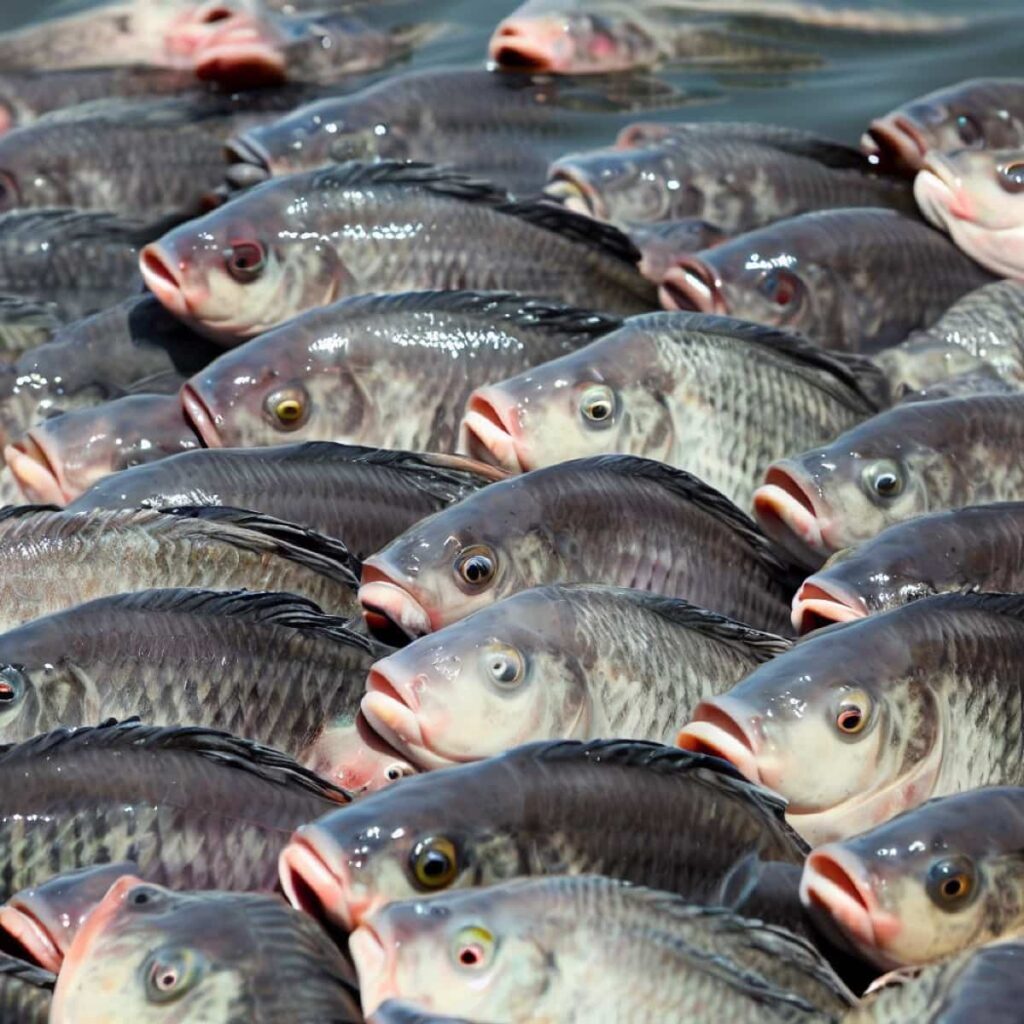
Market Analysis for Tilapia Fish Farming in South Africa
Raising male tilapia fish is a lucrative strategy due to their faster and larger growth than females. Monosex culture, exclusively raising males, maximizes profitability. When it comes to selling your tilapia fish, you have diverse options. Fresh tilapia appeals to urban clients, while dried tilapia suits peri-urban and rural markets. You can also target distributors, wholesalers, supermarkets, butcheries, and informal markets.
Pay attention to the food processing sector, which includes restaurants and fish processing plants. Furthermore, consider breeding and supplying tilapia fish fingerlings, as some restaurants use tilapia fish seeds in their dishes. Expanding your reach to the global market through exports is another potential avenue for revenue.
Selecting suitable land is crucial for tilapia fish farming. Topographically, opt for gently sloping land to prevent flooding and consider an elevated location. Minimal land cover simplifies land preparation. Yet, account for wind patterns and potential vegetative barriers against strong winds. Avoid placing your farm near industrial sites to minimize pollution risks. Also, keep a distance from densely populated areas to reduce the likelihood of pollution from human and vehicle traffic.
Choosing the Right Location for a Tilapia Fish Farm in South Africa
Constructing high-quality fish ponds is essential for a successful and profitable tilapia fish farming venture, and the associated costs should be factored into your business plan. These ponds should include water inlet and outlet systems, such as channels or pipes, with controls to manage water flow and levels. Pond walls are necessary to retain water, and human access pathways must be in place for easy maintenance.
Critical considerations revolve around land, water, and soil. The chosen land should be gently sloped and elevated to prevent flooding. A reliable source of fresh and clean water is paramount, emphasizing water quality tests to ensure suitable conditions for tilapia. Ideal water sources range from wells and boreholes to natural bodies like rivers. Clay soil is also preferred for its impermeability; if it lacks clay, consider adding it to minimize water seepage.
Setting Up a Tilapia Fish Farm: Infrastructure and Equipment Requirements
Constructing tilapia fish ponds is a substantial initial investment in tilapia fish farming. The success of your aquaculture venture hinges on proper pond design and construction. Inadequate design can result in issues like water leakage, structural failures, and incomplete drainage during harvests, leading to future production problems. A well-designed pond, on the other hand, simplifies management, ensures longevity, and boosts profits.
In case you missed it: South Africa Vegetable Planting Calendar: Month Wise, Schedule, Chart, and Guide
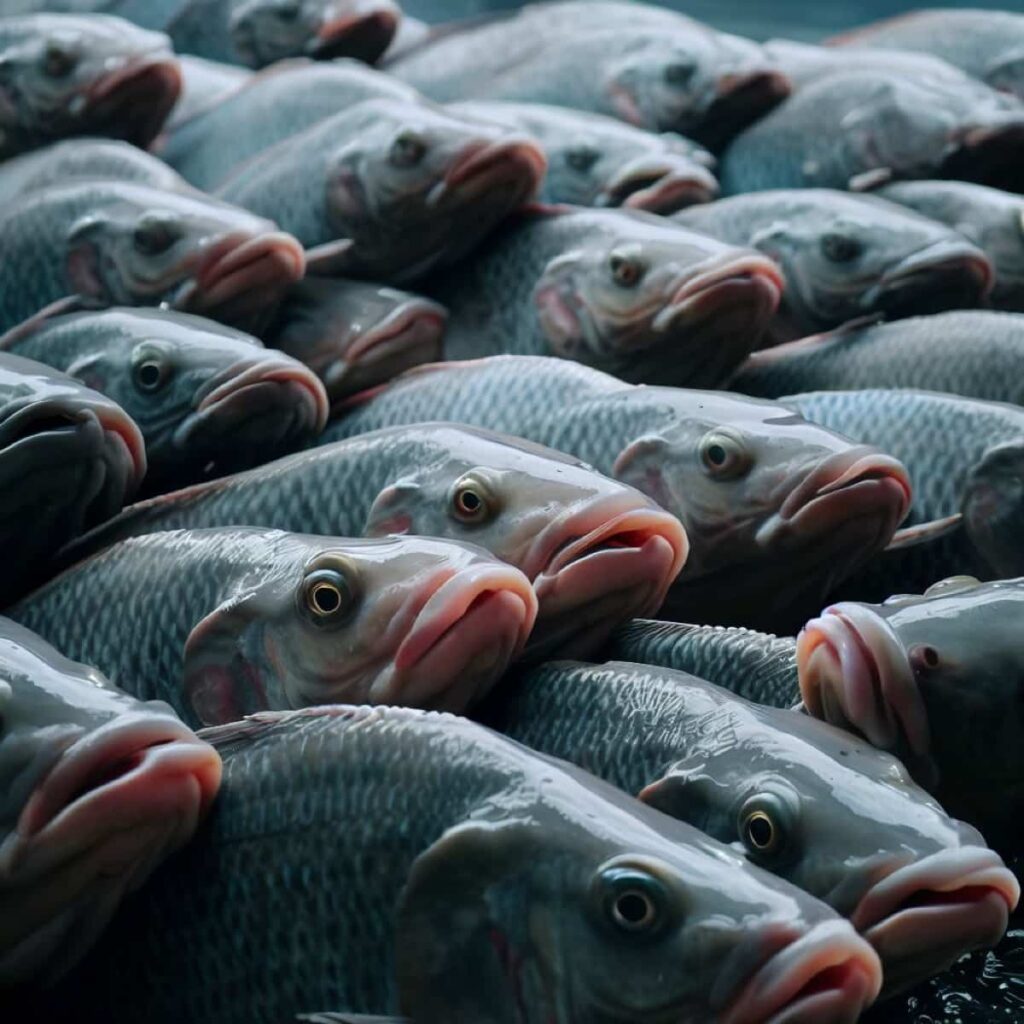
Key dimensions to establish before pond construction include total area, water surface length and breadth, water depth, pond depth (at the deep end), wall slopes, wall height above water level, and wall breadth. A design sketch is essential. After clearing the land, mark the pond’s features and commence excavation, paying attention to necessary adjustments.
Equipment requirements vary based on your automation level. A pumping system, aeration system (pulsed air or mechanical agitation), seine reels, fish graders, fish pumps, fish elevators, and basic handling and storage equipment are essential. Fishing nets aid in harvesting, pond heaters maintain water temperature, refrigerators store harvested fish, and pond filters ensure water quality.
Tilapia Fish Breeding and Hatchery Management in South Africa
Fingerlings are critical in tilapia fish farming in South Africa, especially for meat production. These young fish have reached a stage where their fins are fully formed, and scales have begun to develop across their bodies. At this point, they typically measure about the size of a human finger. There are three primary categories to consider in tilapia fingerlings: fast growth rate, mixed growth rate, and slow growth rate fingerlings.
For those seeking commercial tilapia fish farming, fast-growth rate fingerlings are the top choice, particularly in monosex culture, where predominantly male fingerlings are preferred for their rapid growth. If your ambitions extend to aquaponics, mixed growth rate fingerlings are ideal. On the other hand, slow-growth rate fingerlings are often deployed as pond cleaners due to their high consumption of algae.
When selecting fingerlings, you choose between male fingerlings or male and female fingerlings. Male fingerlings are well-suited for meat production, given their faster growth rate than females. However, if your goal includes breeding, males and females are essential for natural reproduction. It’s crucial to source fingerlings from reputable suppliers with a track record in the tilapia fish farming business, as the quality of these young fish significantly impacts your overall fish growth.
Feeding and Nutrition for Tilapia Fish in South Africa
Feeding and nutrition are pivotal to successful tilapia fish farming in South Africa. Commercial tilapia stock feeds promote rapid and healthy fish growth, typically in pellet and crumble forms. Opting for commercially formulated feeds is crucial to maximize yields and attain substantial tilapia sizes.
In case you missed it: Fish Pond Size Calculator: Ideal Pond Size for 1000, 5000, and 10,000 Fish
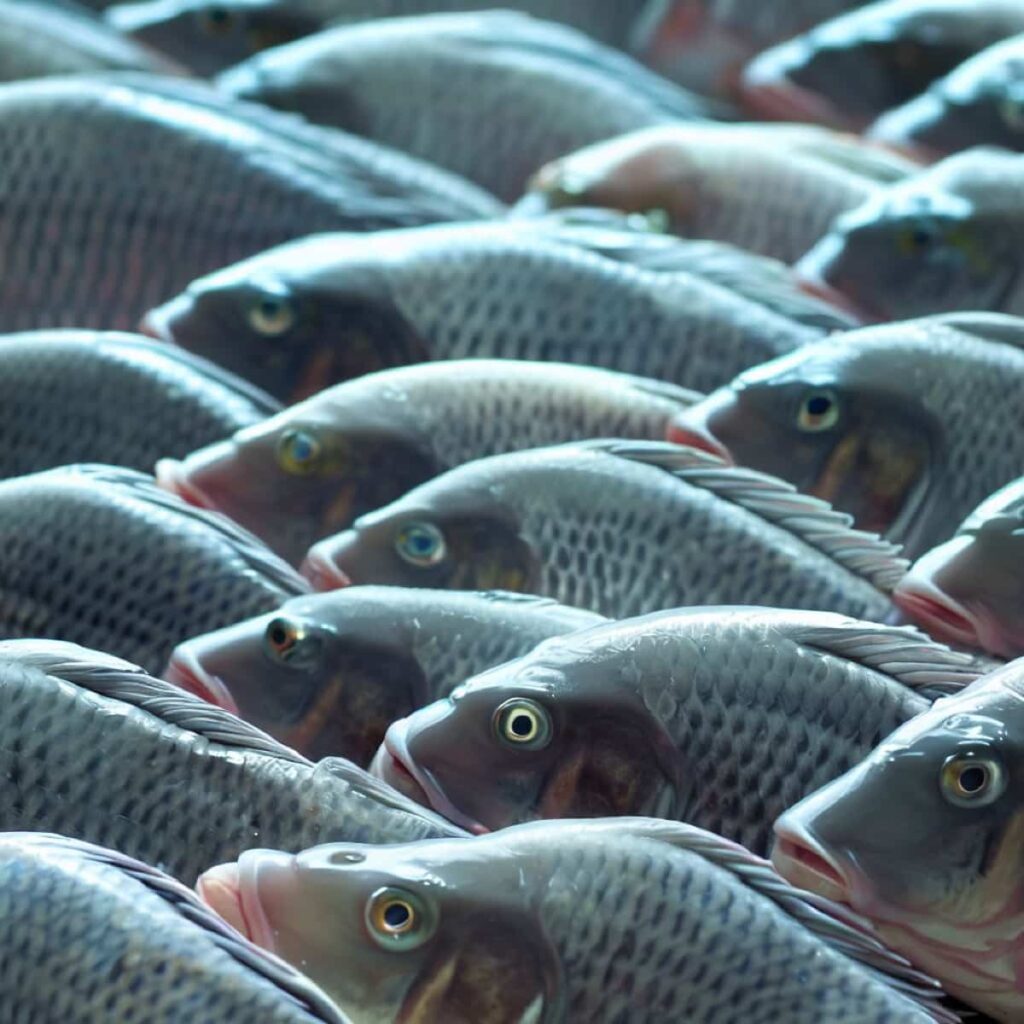
Despite its relatively higher cost, fishmeal is the most recommended option. A key factor in these feeds is the protein content, which should be at least 25 percent. Tilapia fish feeds encompass various types, including compound feed (pelleted or extruded), bran chaff feed, oil cake feed, amphibious plant feed, cereal feed, and animal feed.
Supplementary feeds offer a means to mitigate the high costs of relying solely on commercial fish feed. Introducing manure and fertilizers into the equation can enhance tilapia fish farming business profitability. These additives stimulate the production of natural food organisms within the tilapia fish ponds, including phytoplankton, insects, and zooplankton.
Fertilizers, in particular, promote planktonic algae growth, a critical food source for the fish. Manure options for tilapia fish ponds encompass chicken and piggery manure. Your tilapia farming business plan should meticulously account for commercial and supplementary tilapia fish feed expenses, ensuring a well-balanced and profitable operation.
Water Quality Management in Tilapia Fish Farming
Water quality management in tilapia fish farming is vital for optimal growth and health. It involves monitoring and maintaining parameters like dissolved oxygen, pH levels, temperature, ammonia, and nitrite concentrations. Adequate oxygen levels ensure fish respiration, while proper pH supports nutrient absorption.
Temperature affects metabolism, and controlling ammonia and nitrite prevents toxicity. Efficient filtration systems and regular water testing are crucial for sustaining high water quality standards, promoting healthy tilapia growth, and preventing diseases.
Disease Prevention and Management in Tilapia Fish Farming
Common diseases in tilapia fish farming include bacterial infections (e.g., Streptococcus and Aeromonas), viral diseases (like Tilapia lake virus), and parasitic infestations (e.g., monogenean parasites). Prevention measures include maintaining good water quality, regular health monitoring, and proper nutrition. Implementing biosecurity protocols, avoiding overstocking, and providing available vaccines can mitigate disease risk. In an outbreak, prompt isolation and treatment with antibiotics, antiparasitic drugs, or antiviral agents, if applicable, are essential.
Harvesting and Marketing Strategies for Tilapia Fish Products
In South Africa, the harvesting and processing of tilapia fish involve careful timing and techniques to ensure product quality. Harvesting is typically done using nets or seines, with attention to fish size and maturity. After harvest, fish are processed by cleaning, gutting, and chilling.
Marketing and distribution strategies focus on supplying fresh or frozen tilapia to local markets, supermarkets, butcheries, and restaurants. Export opportunities also exist, particularly in Europe and the United States. The tilapia market in South Africa is substantial, with an estimated annual consumption of over 50,000 metric tons, making effective marketing and distribution crucial for success in this thriving industry.
Financial Planning and Cost Analysis for a Tilapia Fish Farming Business in South Africa
Starting a catfish or tilapia fish farming venture in South Africa can be financially flexible, with initial costs varying depending on the scale and type of operation. For small-scale endeavors, like backyard tarpaulin or plastic pond farming, the investment typically ranges between 10,000 and 15,000 Rands. In contrast, larger-scale projects may require 30,000 to 50,000 Rands.
In case you missed it: How to Convert a Swimming Pool Into Koi Fish Pond: Ideas, Tips, and Techniques
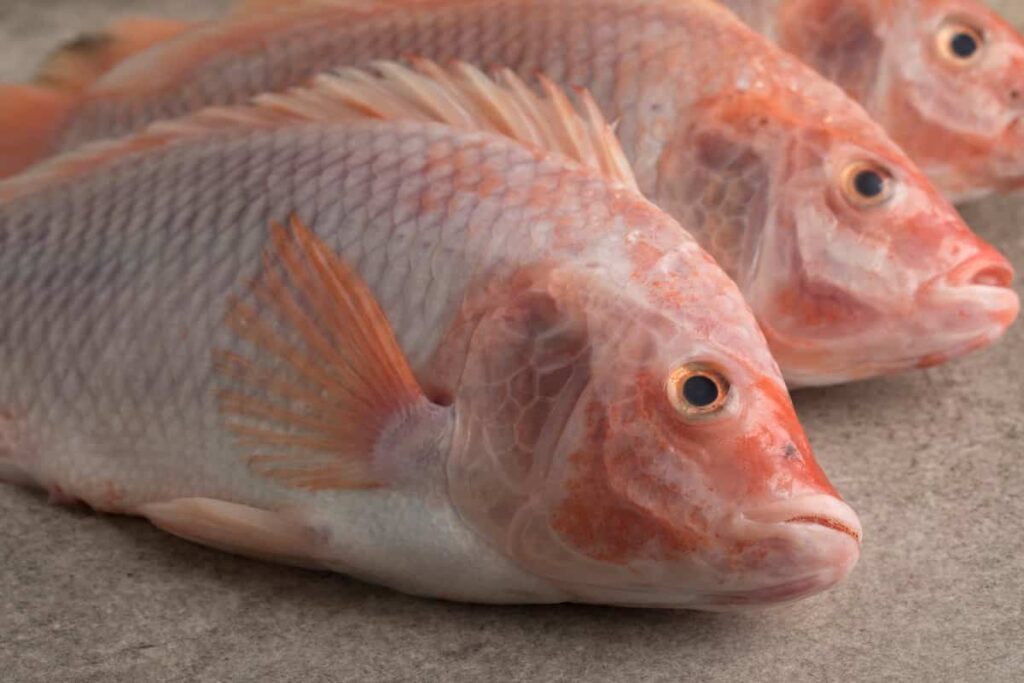
While South Africa boasts a profitable fish farming industry, it is crucial to be aware of common diseases, including fungal, bacterial, protozoan, parasitic, viral, and miscellaneous diseases, and implement proper management practices to ensure success. Tilapia fish farming, in particular, stands out as a lucrative option, accounting for a significant portion of South African fish farming, with an attractive cost of less than one rand per kilo.
Profit Potential and Return on Investment (ROI) for Tilapia Fish Farming in South Africa
The profit potential and return on investment (ROI) in South African tilapia fish farming can be substantial. For instance, a well-managed tilapia farm with a modest investment of 50,000 Rands can yield an annual profit of approximately 30,000 Rands or more. With favorable market conditions and proper management, the ROI in tilapia farming can range from 60% to 100% within the first year, making it an attractive and profitable agricultural venture.
Success Stories and Case Studies of Tilapia Fish Farming Businesses in South Africa
The success story in South African tilapia fish farming is the “Tilapia Trailblazers.” In 2015, a group of entrepreneurs started a tilapia farm in Gauteng Province. They began with a modest investment of 20,000 Rands, constructing earthen ponds and using mixed growth rate fingerlings.
In case you missed it: Unlocking the Potential Of Sustainable Aquaculture: How to Start and What You Need to Know
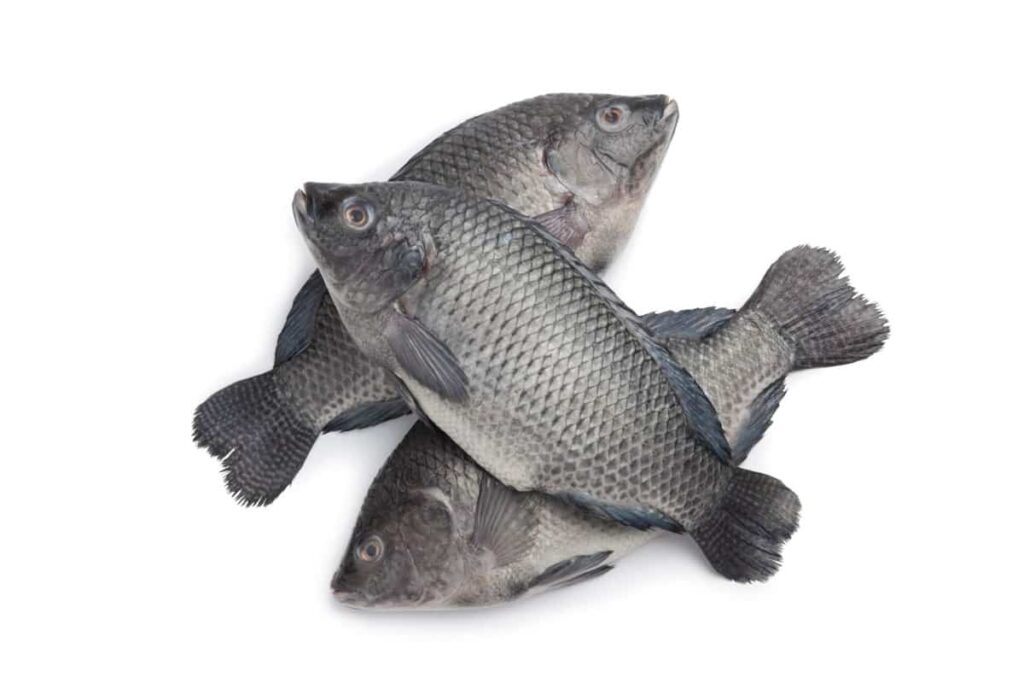
They achieved remarkable results by implementing sound management practices, efficient feeding techniques, and water quality monitoring. Within two years, they expanded their operations, achieving an annual profit of over 100,000 Rands. Their success inspires aspiring tilapia farmers, highlighting the potential for profitability and growth in the South African aquaculture industry when approached with dedication and expertise.
Conclusion
Tilapia fish farming in South Africa offers a promising avenue for entrepreneurs. It can be a financially rewarding venture with the right business plan, cost-effective strategies, and attention to profitability. Adequate research, compliance with regulations, and proper disease management are key factors for success in this thriving industry.
- Sheep Farming Business Plan for Beginners
- Aquaponic Farming at Home: A Step-By-Step Guide
- Profitable Village Farming Business Ideas in 2024
- High-Yield Aquaculture: Fast-Growing Fish for Farming
- Effective Fish Pond Construction Techniques for Beginners
- Irrigation and Water Management in Pineapple Farming
- Blossom to Harvest: Mastering Flowering and Pollination in Papaya Farming
- Pig Fattening Essentials: From Selection to Sale for Beginners
- Raising Wagyu Cattle: A Complete Guide for Premium Beef Production
- Soil Types and Their Water Holding Capacity
- Optimizing Irrigation Schedules for Coconut Groves for Enhanced Yield
- Espresso Your Garden: Coffee Grounds for Healthier Acid-Loving Plants
- The Best Soil Mix for Snake Plants: How to Mix Your Own Snake Plant Soil
- Green Thumb Success: Expert Tips for Cultivating Greenhouse Beans All Year Round
- Bloom All Year Round: The Ultimate Guide to Indoor Hyacinth Care
- Eco-Friendly Gardening: How to Make Liquid Fertilizer from Kitchen Waste
- Ultimate Guide to Grow Anise in Pots: Explore Seed Propagation to Harvesting
- Guide to Raising Chester White Pigs: Discover Breed Facts to Growth Management
- Mastering the Elegance: The Ultimate Guide to Weeping Cherry Tree Care, Planting, and Maintenance
- Ultimate Guide to Planting Garlic in Grow Bags: Growing Strategies for Beginners
- How to Fix Spider Plant Leaf-Related Problems: Natural and Organic Remedies
- 10 Reasons Why Your Tulsi Plant is Shedding Leaves: Home Remedies and Solutions
- Optimizing Growth and Yield: The Advantages of Palm Bunch Ash Fertilizer
- Utilizing Neem Oil Extract as a Natural Pesticide for Hydrangea
- From Soil to Harvest: Various Ways in Which Farmers Can Use AI Tools
- Steps to Encourage and Induce Citrus Flowers: A Comprehensive Guide
- How to Fix Snake Plant Leaf-Related Issues: Natural and Organic Remedies
- Transform Your Garden into a Fragrant Oasis with Raat Ki Rani (Night Blooming Jasmine)
- Discover the Ideal Chicken Breeds for Philippine Farms
- How to Create a Poultry Egg Farm Business Plan for Profits
- Grow Lemon Cucumbers Like a Pro: Insider Techniques for Bountiful Yields
- Ultimate Guide to Caring for Your Pink Princess Philodendron: Tips for Thriving Variegation
- Areca Nut Profit Per Acre: Calculating Yield and Cost of Cultivation
- How Kaveri Chicken is Becoming a More Profitable Breed in Indian Backyards
- Transform Your Barn: 9 Steps to Convert a Horse Stall into a Chicken Coop
- Exploring Suffolk Sheep Disadvantages with Limitations and Challenges
